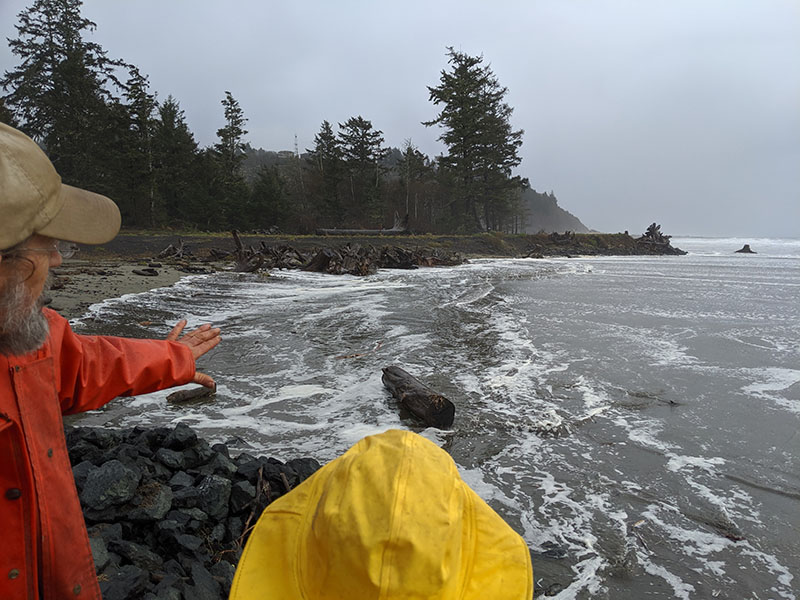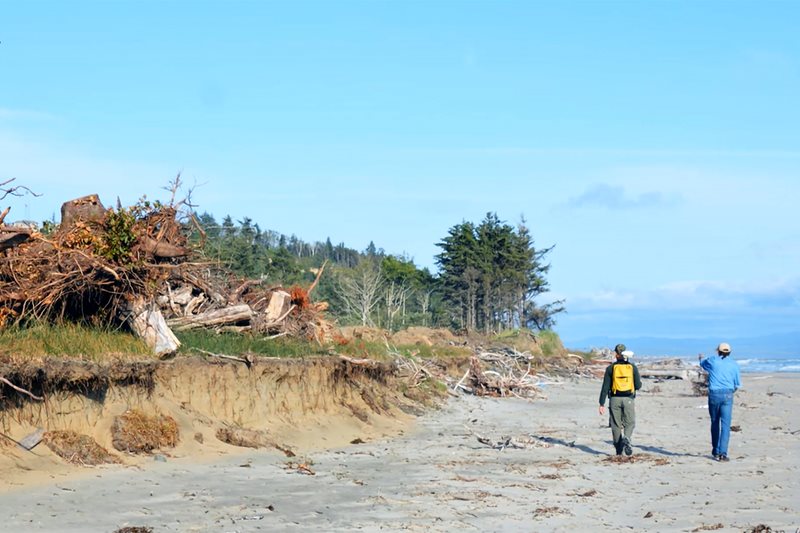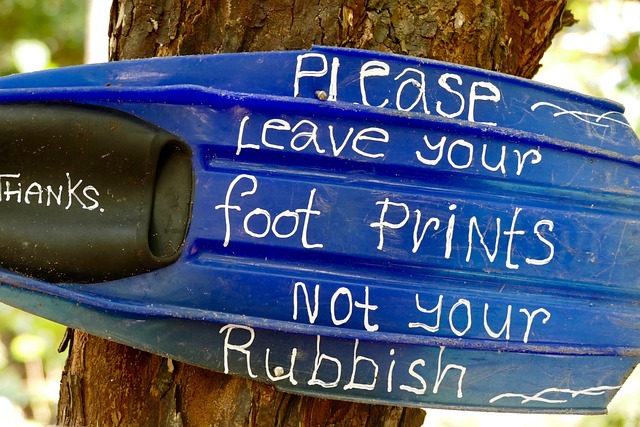
David Cottrell, commissioner of Pacific County Drainage District 1, explains how a cobble dynamic revetment in North Cove absorbs wave energy and naturally reforms to mitigate erosion and rebuild protective dunes.
Our Coastal Zone Management (CZM) Program is crossing oceans this December to share coastal resilience research with the world.
Between Dec. 4-9, Ecology coastal engineer George Kaminsky will present “Monitoring of a Dynamic Revetment during a Spring Tidal Cycle in North Cove, Washington State, U.S.A.” to coastal engineers and scientists during the 37th annual International Conference on Coastal Engineering in Sydney, Australia.
North Cove is located along Washington’s Pacific Ocean coast in Pacific County and is where we teamed up with the local community to work together on the anti-erosion project.
“We investigated how a backshore cobble berm constructed at North Cove in front of an eroding dune dynamically adjusts to high waves and water levels to effectively stop coastal erosion,” Kaminsky said. “We learned that it is important to have a range of cobble and gravel sizes to naturally form a sub-surface filter layer. This protects the underlying beach sand from eroding because the wave energy is absorbed by the overlying cobbles. Following storm events, waves deposit sand on the cobble material to quickly rebuild the beach to provide a greater buffer for subsequent storms.”
Erosion of banks, bluffs and beaches is a recurring issue along the coast.
Cobble berms naturally provide a stabilizing effect on coasts otherwise subject to erosion. Large woody material and vegetation play a complementary role and increase the capacity to retain sand and naturally rebuild protective dunes. Because the approach uses natural materials that dynamically adjust to waves and water levels, it can adapt to climate change and sea level rise to provide long-term coastal resilience. The approach is modeled after naturally occurring cobble beaches found on other parts of the Washington coast.
Kaminsky is working in tandem with Heather Weiner, a natural resources scientist at Ecology; Paul M. Bayle, University of Bath, UK; Chris E. Blenkinsopp, University of Bath, UK; and David Cottrell, Pacific County Drainage District 1, North Cove. He hopes the research raises awareness about innovative nature-based approaches to successfully counter severe coastal erosion and gains international acceptance as a viable coastal engineering practice.
“We will continue monitoring and learning how to optimize designs to enhance the application of the approach in other locations.”
"This is critical for us to secure tens of millions of dollars in proposed grants and contracts to implement these approaches at Graveyard Spit, Benson Beach, and elsewhere along the Washington coast,” Kaminsky said. “We will continue monitoring and learning how to optimize designs to enhance the application of the approach in other locations.”
Fifty years of shoreline and coastal conservation
This month marks the 50th anniversary of the federal Coastal Zone Management Act (CZMA). Congress passed the banner legislation in October 1972 to protect our nation's oceans and coasts. The CZMA created a framework for states to take on the primary role in managing their coastal zone, in partnership with the National Oceanic and Atmospheric Administration (NOAA). In 1976, Washington was the first state to receive federal approval of a Coastal Zone Management Program by preparing a document describing the state's coastal resources and how they're managed.
By continuing to maintain this federally approved program, Washington receives funding from the federal government to support our ongoing shoreline and coastal management efforts. In addition, the CZMA’s federal consistency provisions give Washington a role in the federal decision-making process for activities that could affect the state’s coastal resources.
Several recent coastal resilience efforts spearheaded by Washington’s Coastal Zone Management Program are highlighted below:
-
Washington Coastal Hazards Risk Reduction Project Mapper: This map displays a collection of coastal hazard resilience project case studies. Working in partnership with the Federal Emergency Management Agency and the Nature Conservancy, this resource assists individuals, communities, and local governments identify practical approaches to coastal hazards and learn from others facing similar issues in Washington. The goal is to build a network of people supporting resilient coastal communities and ecosystems.
-
The Washington Coast Resilience Action Demonstration Project (RAD): A two-year partnership between Ecology and Washington Sea Grant provided multi-organizational hazards assistance to Pacific coast communities and laid the groundwork for future coastal resilience efforts. Funded by NOAA, the RAD was a response to urgent needs voiced by coastal communities and Tribes seeking to build local capacity to address coastal hazards issues while strengthening the long-term social, economic, and ecological resilience of the Pacific coast.
-
Coastal Resilience Partnership with Guam: Washington Coastal Zone Management Program staff were invited by Guam's Coastal Management Program to offer technical assistance tailored to residents and community organizations. A recent recorded presentation demonstrates the collaborative strength fostered by the Coastal States Organization (CSO) to better understand coastal vulnerabilities and design more effective risk reduction projects with nature. As a result of this visit, Guam is now actively working to implement a dynamic revetment on an eroding shoreline on the island's western coast. Read a short summary of the work here.
How you can show your support
We encourage everyone to support ocean and coast conservation, with acts that are big and small. Not every solution is possible for every household, but here are some actions you can take to show your love for our ocean and coasts.
What’s next?
In the coming months, we will share updates from ongoing coastal projects and research, including:
-
The Willapa Erosion Control Action Now community forum’s progress on developing a long-term plan to address chronic beach erosion in North Cove and Tokeland in Pacific County.
-
Efforts by the city of Ocean Shores to assess and plan for chronic erosion in Oyhut Bay in Grays Harbor County.
-
A sea level rise resilience strategy for Baker and Grays bays, which stems from an effort to address current and future flooding at the ports of Ilwaco and Chinook that threaten marinas and surrounding communities in Pacific County.
For more information, contact:
Henry Bell, Ecology coastal planner, 360-628-2750



